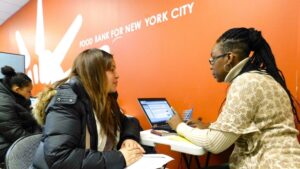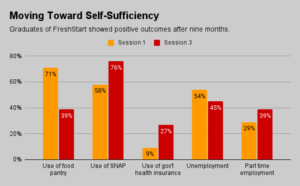At Oregon Food Bank, the path toward greater equity is starting from within.
The food bank is one of the few and perhaps the only to have created a senior leadership position dedicated to addressing equity. The person who fills that role, Rut Martinez-Alicea, Director of Equity, People & Culture, has been tasked with tamping down systemic inequities by snuffing out aspects of the food bank’s culture that reinforce them.
By focusing on its own organization, Oregon Food Bank’s efforts are distinct from those of other food banks that tend to look outward to the communities they serve when taking on inequity. The Food Bank of Western Massachusetts, for example, has successfully taken steps to even out inequities in food distribution by bringing additional services into areas identified as having the least resources.

While Oregon Food Bank has not ignored these types of externally-facing efforts, Martinez-Alicea is much more concerned about what’s happening inside the food bank, rather than outside. “My main charge is internal facing,” Martinez-Alicea said. “The assumption is that structures of inequity live in our policies and practices.”
Martinez-Alicea, who started at the food bank in 2018, is at the very beginning stages of steering Oregon Food Bank along a slow but massive culture shift as it takes steps toward fulfilling its ten-year vision. A key element of the vision is that equity will be knitted into every aspect of the operation, from day-to-day routines to overarching goals. In other words, there is no plan for equity in Oregon Food Bank’s strategic plan. “Our strategic plan is our equity plan,” Martinez-Alicea explained.
Ensuring the equity plan and the strategic plan are one and the same has required the food bank to take some very specific steps. Oregon Food Bank began its journey by forming an equity team. While the team included representatives and leaders from all of the food bank’s departments, the plan for equity still remained separate from the plan for the organization.
Over time, the food bank evolved to using SMARTIE goals, an enhancement of the SMART business standard in goal-setting (an acronym standing for specific, measurable, achievable, relevant and time-bound) that incorporates the addition of IE for inclusive and equitable. (SMARTIE goals are the creation of The Management Center, an outfit that offers management training for social-change organizations.)
From those goals, the food bank created activities and measurements of success that now form the organization’s overall work plan. “There are no separate goals for equity,” Martinez-Alicea explained. “The goals are for everything.”
Being more intentional about equity and inclusion has resulted in some dramatic changes in basic operating procedures, Martinez-Alicea said. For example, the food bank is seeking to compensate its employees fairly according to the market, but also with the understanding that the market replicates inequities.
Through that lens, the food bank has better understood how it might be exploiting bi-lingual cultures by indicating a preference for foreign-language speakers in its hiring, but not providing extra compensation for that skill. Similarly, the food bank is seeking to move away from applying cost of living adjustments evenly across the organization. Its new perspective acknowledges that greater increases in cost of living adjustments are needed for lower-wage earners.
“It’s transformative and is counter in some important ways to the American mythology that all should be treated equally,” Martinez-Alicea said.
Martinez-Alicea acknowledges that achieving equity throughout the organization will take a long time. Even a cursory look at the food bank’s senior leadership team and board of directors shows that the food bank has a ways to go in terms of assembling a more inclusive staff. But Martinez-Alicea downplays the notion that the food bank should work toward a quota in its hiring, noting that quotas are a construct of the dominant culture, and the “language of the dominant culture is numbers.”
Rather than work toward a quota, the food bank is creating rubrics for hiring that emphasize skill sets related to experience with hunger and systemic inequity. New strategies and tactics, such as ways of hiring that do not emphasize traditional performance measurements, will help people of color feel welcome, Martinez-Alicea said. “Rather than an increase in diversification we will have an increase in an environment that is conducive to thriving at maximum capacity,” she said.
Ultimately, Martinez-Alicea would like to see Oregon Food Bank make significant progress in understanding that it cannot buy its way out of hunger, she said. “Hunger is not a problem of money,” she noted. “It’s a systemic inequity problem. So if we continue to dedicate resources to a model of food distribution and not appropriately fund the resources that lead to structural change, then we are not being good stewards of our funding — and we are being ineffective.”
Connect with Us:















